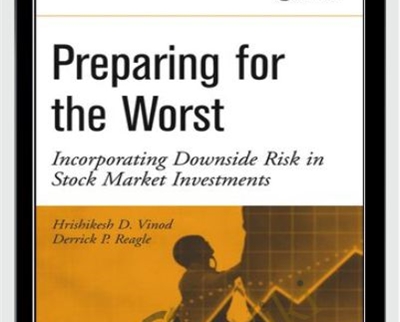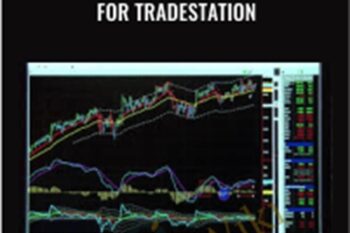Achieve more with the Preparing For The Worst Incorporating Downside Risk In Stock Market Investments – Hrishikesh Vinod and Derrick Reagle course, priced at just Original price was: $130.00.$23.00Current price is: $23.00. on GBESY.biz! Explore our extensive collection of over 60,000 downloadable courses in Forex and Trading. We offer professional, self-paced digital education at up to 80% off original rates. Start transforming your expertise now!
Salepage link: At HERE. Archive:
$130 $28 – Preparing For The Worst Incorporating Downside Risk In Stock Market Investments – Hrishikesh Vinod and Derrick Reagle
A timely approach to downside risk and its role in stock market investments
When dealing with the topic of risk analysis, most books on investments treat downside and upside risk equally. Preparing for the Worst takes an entirely novel approach by focusing on downside risk and explaining how to incorporate it into investment decisions. Highlighting this asymmetry of the stock market, the authors describe how existing theories miss the downside and follow with explanations of how it can be included. Various techniques for calculating downside risk are demonstrated.
This book presents the latest ideas in the field from the ground up, making the discussion accessible to mathematicians and statisticians interested in applications in finance, as well as to finance professionals who may not have a mathematical background. An invaluable resource for anyone wishing to explore the critical issues of finance, portfolio management, and securities pricing, this book:
- Incorporates Value at Risk into the theoretical discussion
- Uses many examples to illustrate downside risk in U.S., international, and emerging market investments
- Addresses downside risk arising from fraud and corruption
- Includes step-by-step instructions on how to implement the methods introduced in this book
- Offers advice on how to avoid pitfalls in calculations and computer programming
- Provides software use information and tips
TABLE OF CONTENTS
- List of Figures.
- List of Tables.
- Preface.
1. Quantitative Measures of the Stock Market.
- 1.1. Pricing Future Cash Flows.
- 1.2. The Expected Return.
- 1.3. Volatility.
- 1.4. Modeling of Stock Price Diffusion.
- 1.5. Efficient Market Hypothesis.
- Appendix: Simple Regression Analysis.
2. A Short Review of the Theory of Risk Measurement.
- 2.1. Quantiles and Value at Risk.
- 2.2. CAPM Beta, Sharpe, and Treynor Performance Measures.
- 2.3. When You Assume . . . .
- 2.4. Extensions of the CAPM.
- Appendix: Estimating the Distribution from the Pearson Family of Distributions.
3. Hedging to Avoid Market Risk.
- 3.1. Derivative Securities: Futures, Options.
- 3.2. Valuing Derivative Securities.
- 3.3. Option Pricing Under Jump Diffusion.
- 3.4. Implied Volatility and the Greeks.
- Appendix: Drift and Diffusion.
4. Monkey Wrench in the Works: When the Theory Fails.
- 4.1. Bubbles, Reversion, and Patterns.
- 4.2. Modeling Volatility or Variance Explicitly.
- 4.3. Testing for Normality.
- 4.4. Alternative Distributions.
5. Downside Risk.
- 5.1. VaR and Downside Risk.
- 5.2. Lower Partial Moments (Standard Deviation, Beta, Sharpe, and Treynor).
- 5.3. Implied Volatility and Other Measures of Downside Risk.
6. Portfolio Valuation and Utility Theory.
- 6.1. Utility Theory.
- 6.2. Nonexpected Utility Theory.
- 6.3. Incorporating Utility Theory into Risk Measurement and Stochastic Dominance.
- 6.4. Incorporating Utility Theory into Option Valuation.
- 6.5. Forecasting Returns Using Nonlinear Structures and Neural Networks.
7. Incorporating Downside Risk.
- 7.1. Investor Reactions.
- 7.2. Patterns of Downside Risk.
- 7.3. Downside Risk in Stock Valuations and Worldwide Investing.
- 7.4. Downside Risk Arising from Fraud, Corruption, and International Contagion.
8. Mathematical Techniques.
- 8.1. Matrix Algebra.
- 8.2. Matrix-Based Derivation of the Efficient Portfolio.
- 8.3. Principal Components Analysis, Factor Analysis, and Singular Value Decomposition.
- 8.4. Ito’s Lemma.
- 8.5. Creation of Risk-Free Nonrandom g(S, t) as a Hedge Portfolio.
- 8.6. Derivation of Black-Scholes Partial Differential Equation.
- 8.7. Risk-Neutral Case.
9. Computational Issues.
- 9.1. Sampling, Compounding, and Other Data Issues in Finance.
- 9.2. Numerical Procedures.
- 9.3. Simulations and Bootstrapping.
- Appendix A: Regression Specification, Estimation, and Software Issues.
- Appendix B: Maximum Likelihood Estimation Issues.
- Appendix C: Maximum Entropy (ME) Bootstrap for State-Dependent Time Series of Returns.
10. What Does It All Mean?
- Glossary of Greek Symbols.
- Glossary of Notations.
- Glossary of Abbreviations.
- References.
- Name Index.
- Index.
$130 $28 – Preparing For The Worst Incorporating Downside Risk In Stock Market Investments – Hrishikesh Vinod and Derrick Reagle
Invest in endless knowledge with the Preparing For The Worst Incorporating Downside Risk In Stock Market Investments – Hrishikesh Vinod and Derrick Reagle course at GBESY.biz! Gain lifetime access to premium digital content designed to fuel your professional and personal growth.
- Lifetime Access: Unrestricted, permanent access to your purchased courses.
- Unbeatable Value: Save significantly with prices up to 80% less than direct purchases.
- Protected Payments: Complete your transactions securely.
- Empowering Skills: Learn practical, in-demand skills for immediate application.
- Immediate Download: Access your course content instantly after purchase.
- Any Device, Anywhere: Study on your preferred device with full flexibility.
Discover your next opportunity with GBESY.biz!
![GBesy [GB] GBesy [GB]](https://gbesy.biz/wp-content/uploads/2023/05/gbesy-Logo-full-100.png)
![GBesy [GB] GBesy [GB]](https://www.gbesy.com/wp-content/uploads/2023/05/gbesy-Logo-full-100.png)



 Purchase this course you will earn
Purchase this course you will earn 





Reviews
There are no reviews yet.